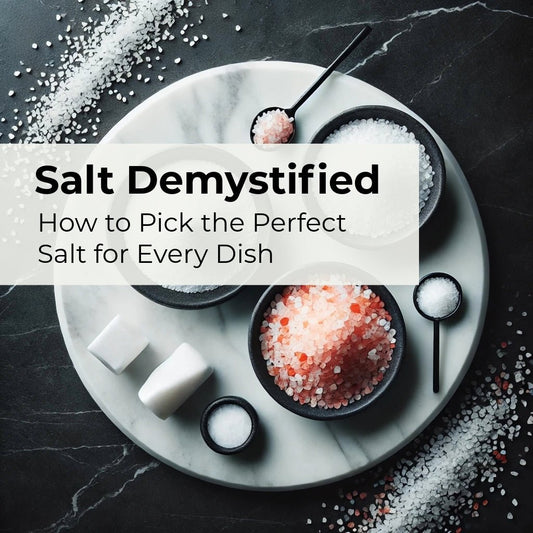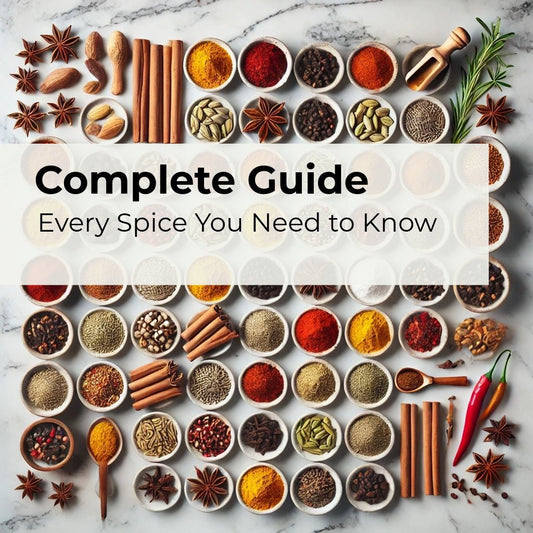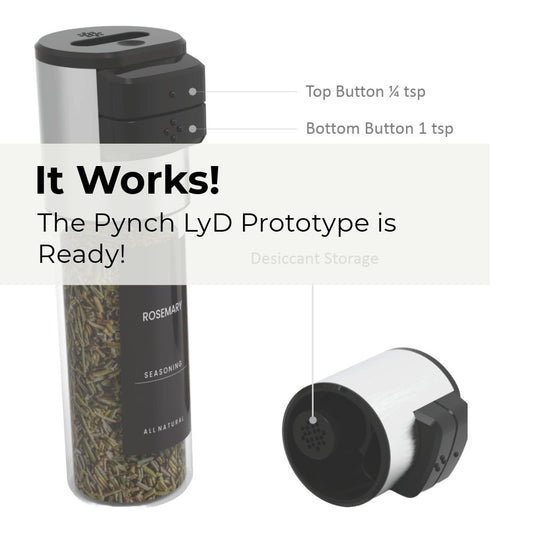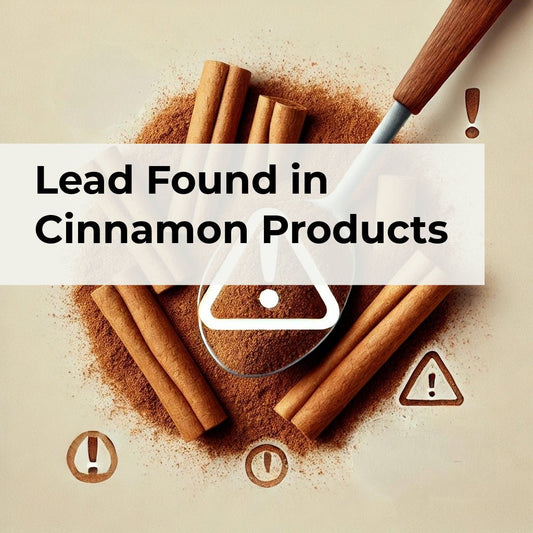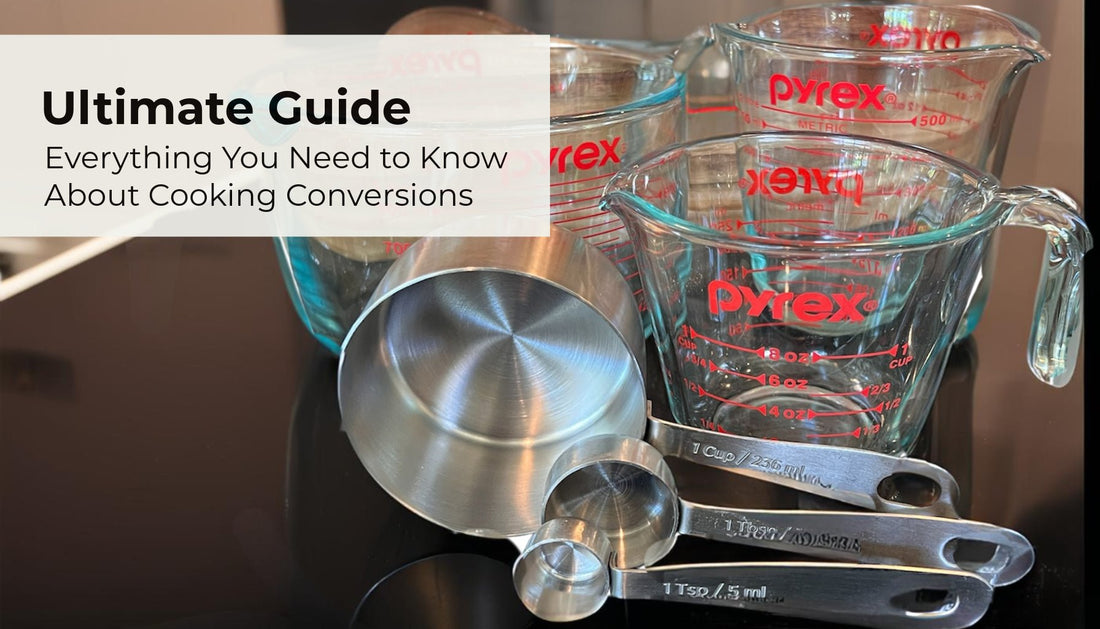
Ultimate Guide: Everything You Need to Know About Cooking Conversions
Share
Cooking, whether you're a seasoned chef or a casual home cook, often involves converting measurements between various units. This becomes even more critical when dealing with recipes that use different systems, such as converting from teaspoons to tablespoons or ounces to milliliters. Understanding these conversions can make a world of difference in the kitchen, especially when it comes to the precision required for measuring spices.
But since many of you just want the damn quick reference, below are quick summary tables. You can also buy a magnetic one to have at home, I use this: LINK (I may get commission at no cost to you if you purchase this)
Table 1: Common Kitchen Measurements
|
Teaspoon (tsp) |
Tablespoon (tbsp) |
Fluid Ounces (fl oz) |
Cup |
Pint |
|
1 tsp |
1/3 tbsp |
0.1667 fl oz |
0.0208 cups |
0.0104 pints |
|
3 tsp |
1 tbsp |
0.5 fl oz |
0.0625 cups |
0.0313 pints |
|
6 tsp |
2 tbsp |
1 fl oz |
0.125 cups |
0.0625 pints |
|
48 tsp |
16 tbsp |
8 fl oz |
1 cup |
0.5 pints |
|
96 tsp |
32 tbsp |
16 fl oz |
2 cups |
1 pint |
Table 2: Volume Conversion
| Milliliters (ml) | Fluid Ounces (fl oz) | Cups | Pints | Liters | Quarts |
|---|---|---|---|---|---|
| 1 ml | 0.0338 fl oz | 0.0042 cups | 0.0021 pints | 0.001 liters | 0.0011 quarts |
| 29.5735 ml | 1 fl oz | 0.125 cups | 0.0625 pints | 0.0296 liters | 0.0313 quarts |
| 237 ml | 8 fl oz | 1 cup | 0.5 pints | 0.24 liters | 0.25 quarts |
| 473 ml | 16 fl oz | 2 cups | 1 pint | 0.47 liters | 0.5 quarts |
| 1,000 ml | 33.814 fl oz | 4.2268 cups | 2.1134 pints | 1 liter | 1.0567 quarts |
| 946 ml | 32 fl oz | 4 cups | 2 pints | 0.95 liters | 1 quart |
If that's all you needed, we are happy you got it quick, but if you want to learn more, keep on reading.
Converting Dry & Fresh Spices
Converting dry herbs to fresh herbs is fairly straightforward. The general rule of thumb is:
1 part dried herbs = 3 parts fresh herbs.
This ratio is used because dried herbs are more concentrated in flavor than fresh herbs. When herbs are dried, they lose water content but retain their essential oils, which makes their flavor more potent.
Conversion Examples:
- 1 teaspoon dried thyme = 3 teaspoons (or 1 tablespoon) fresh thyme.
- 1/2 teaspoon dried oregano = 1 1/2 teaspoons fresh oregano.
- 1 teaspoon dried basil = 3 teaspoons fresh basil.
Understanding the Metric vs. Imperial Systems
Before diving into more conversions, it’s important to understand the two primary measurement systems used in cooking: the metric system and the imperial system.
- Metric System:
- The metric system is based on units of ten and is used in most parts of the world. Common units in the metric system include grams for weight and liters or milliliters for volume.
- Example: 1 liter = 1,000 milliliters, and 1 kilogram = 1,000 grams.
- Imperial System:
- The imperial system, used primarily in the United States, includes units such as pounds, ounces, and cups for weight and volume.
- Example: 1 pound = 16 ounces, and 1 cup = 8 fluid ounces.
Fluid Ounces vs. Weight-Based Ounces (WT OZ): What’s the Difference?
One of the most common areas of confusion in cooking is the difference between fluid ounces (a measure of volume) and weight-based ounces (WT OZ, a measure of mass or weight).
- Fluid Ounces (fl oz):
- Fluid ounces measure volume, not weight. They are used for measuring liquids like water, milk, or oil. For example, 1 cup of water is equal to 8 fluid ounces.
- How to Recognize It: If a recipe or product refers to ounces in the context of liquids, it's likely referring to fluid ounces. This is especially common when the measurement is given for something typically measured in volume, like a drink or a cooking liquid.
- Weight-Based Ounces (WT OZ):
- Weight-based ounces (WT OZ) measure the mass or weight of an ingredient. This is commonly used for dry ingredients like flour, sugar, or meat.
- How to Recognize It: If a recipe specifies ounces for something like flour, sugar, or spices, it’s referring to weight. This is often indicated as “WT OZ” or just “oz” without the “fl” prefix.
Common Measurement Units in Cooking and Baking
To ensure your recipes turn out perfectly every time, it's crucial to understand the various units used in cooking and baking. Here's a comprehensive list of the most common measurements:
Volume (Imperial System)
- Teaspoon (tsp): Commonly used for measuring small quantities, such as spices, baking powder, and extracts.
- Tablespoon (tbsp): Three teaspoons make up one tablespoon, often used for slightly larger quantities like oil or sugar.
- Cup: There are 16 tablespoons in one cup, commonly used for flour, sugar, liquids, and other larger quantities.
- Pint (pt): One pint equals 2 cups or 16 fluid ounces. Used for measuring liquids such as milk or cream.
- Quart (qt): One quart equals 2 pints or 4 cups, often used for larger liquid quantities.
- Gallon (gal): One gallon equals 4 quarts or 16 cups, typically used for very large quantities of liquids.
Volume (Metric System)
- Milliliter (ml): A small metric unit of volume, often used for measuring liquids and small quantities of ingredients.
- Liter (l): One liter equals 1,000 milliliters, commonly used for measuring larger liquid quantities.
Weight (Imperial and Metric Systems)
- Ounce (WT OZ): A small unit of weight used for dry ingredients like spices, nuts, and baking powder.
- Pound (lb): One pound equals 16 ounces, commonly used for measuring meat, flour, and other larger quantities.
- Gram (g): A small metric unit of weight, often used for precise measurements of spices, baking ingredients, and small quantities.
- Kilogram (kg): One kilogram equals 1,000 grams, used for larger quantities of dry ingredients or meat.
Converting Between Ounces and Milliliters
When cooking, especially with liquid ingredients, you may need to convert between ounces and milliliters. Ounces are part of the imperial system, while milliliters are a metric unit.
- Fluid Ounces (fl oz): A unit of volume commonly used for measuring liquids in the imperial system.
- Milliliters (ml): A metric unit of volume, where 1 milliliter equals 0.0338 fluid ounces.
For ease of use in the kitchen, many cooks round these numbers to 30 milliliters per ounce. This slight rounding difference generally does not affect the outcome of a recipe significantly.
Volume vs. Weight: When to Use Each
In cooking, ingredients can be measured by volume (teaspoons, tablespoons, cups, milliliters) or by weight (grams, ounces). The choice between these two depends on the ingredient and the recipe.
Volume Measurements:
Volume is often used for liquids, spices, and baking ingredients like flour and sugar. It's convenient and quick but can be less precise than weight, particularly with ingredients that vary in density. For example, a cup of finely ground flour will weigh more than a cup of sifted flour due to the amount of air trapped between the particles.
Weight Measurements:
Weight measurements are more precise and are often used for ingredients like meat, cheese, and dry goods where consistency matters. For example, a recipe may call for 8 ounces of chicken breast or 200 grams of chocolate.
When to Use Each:
- Liquids: Always measured by volume.
- Dry Ingredients: Typically measured by volume in most home kitchens, but weight measurements provide more accuracy, especially in baking.
- Spices: Most recipes use volume measurements (teaspoons, tablespoons) for spices. However, in some professional kitchens, spices may be measured by weight to ensure consistency, especially in large-scale production.
Applying These Concepts to Spices
Spices are a unique category where the choice between volume and weight can have a significant impact on the final dish. Here’s why:
- Variability in Density: Spices vary greatly in density. For example, a teaspoon of ground cinnamon is much denser and heavier than a teaspoon of dried oregano leaves. Measuring by volume can lead to inconsistent results, especially when substituting one spice for another.
- Precision in Recipes: For everyday cooking, measuring spices by volume (teaspoons, tablespoons) is usually sufficient. However, if you’re working on a recipe that requires precise seasoning, or if you’re scaling a recipe up or down, it might be worth switching to weight measurements. A digital kitchen scale can help here.
To help you with this, we've compiled a table of the top 20 most popular spices, including salt variations and chili flakes, and their conversions from 1 teaspoon to grams. This reference can be invaluable when you're looking to measure spices with greater accuracy.
Top 20 Most Popular Spices and Their 1 Teaspoon to Grams Conversion
|
Spice |
1 tsp (g) |
|
Cinnamon (ground) |
2.6 |
|
Cumin (ground) |
2.5 |
|
Paprika (ground) |
2.3 |
|
Oregano (dried) |
1.0 |
|
Basil (dried) |
1.0 |
|
Garlic Powder |
2.8 |
|
Onion Powder |
2.4 |
|
Turmeric (ground) |
2.0 |
|
Black Pepper (ground) |
2.3 |
|
Cayenne Pepper |
2.0 |
|
Coriander (ground) |
2.0 |
|
Thyme (dried) |
1.2 |
|
Rosemary (dried) |
1.2 |
|
Nutmeg (ground) |
2.5 |
|
Ginger (ground) |
2.1 |
|
Mustard Powder |
2.9 |
|
Cloves (ground) |
2.1 |
|
Cardamom (ground) |
2.0 |
|
Fennel Seed (ground) |
2.1 |
|
Allspice (ground) |
2.6 |
|
Table Salt |
2.6 |
|
Kosher Salt |
3.0 |
|
Sea Salt |
2.8 |
|
Chili Flakes |
2.0 |
Conclusion: The Best of Both Worlds
Understanding conversions, the differences between the metric and imperial systems, and when to use volume vs. weight measurements can elevate your cooking, particularly when it comes to spices. While volume measurements are quick and convenient, weight measurements offer precision that can be crucial for certain recipes. By mastering these basics, you’ll be better equipped to tackle any recipe with confidence, ensuring your dishes are consistently flavorful and well-seasoned.
Remember, cooking is as much about creativity as it is about precision. Armed with this knowledge, you can confidently adjust recipes, experiment with flavors, and enjoy the process of creating delicious meals at home.


